Flush mechanism for toilet bowl
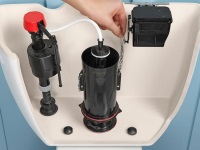
A faulty drain mechanism does not allow the drainage procedure to be carried out. A special mechanism is responsible for its operation. To understand the nuances of its work, repair, it is necessary to get acquainted in detail with the device itself, its types and other parameters. It is about this that we will talk to you today in our material.
Types
Today there are two types of drain mechanisms:
- Single-mode;
- Two-mode.
In the first case, the drain is carried out by using the entire volume of liquid that is inside the tank.
In the second one, there are two buttons responsible for draining a certain amount of water - more and less. The use of such systems is justified because they save water by not using the entire volume when it is not necessary.
Despite the differences in the type of drain mechanism, the principle of its operation is the same. Only the movement of the valve, which closes the drain hole, is different.
The design of this valve determines how it functions. In some cases, this valve is mounted on the end of tubular stems that act as an overflow. In other models, the valve is closed and opened by the use of chains made of plastic or metal. This principle cannot be called successful, because the system often fails.
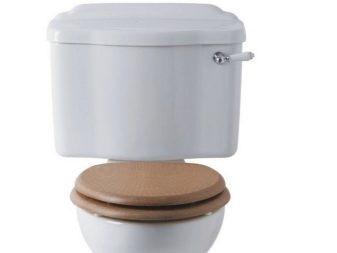
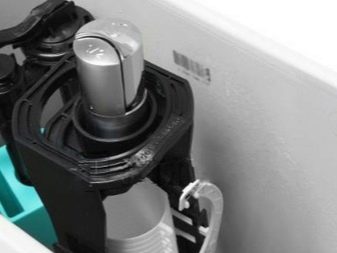
Buttons are divided into two types. One is mounted independently of each other, the other provides the opening of the valve by means of plastic levers.
The nuances of the flushing device of the reservoir for draining allow them to distinguish from each other. As a result, there are two types available today:
- Lateral. This mechanism is relevant for containers with water (tanks), which are located high above the bowl. To run, you need a special rope. If the tank is located low, then a button is provided on the side.
- Upper. Relevant for tanks installed below or mounted in the wall. The system works by means of a button or head. They, in turn, are activated manually or automatically.
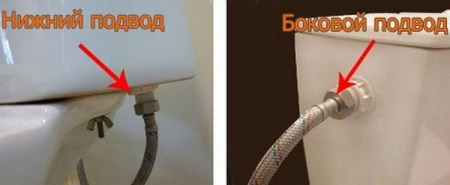
The main elements
Before we begin to perform any repair or preventive work, let's understand the very device of the drain.
Each toilet model is equipped with two main elements - the bowl and the tank, that is, the cistern of the drain.
After removing the lid from the cistern, under it you will see the drainage system. It includes float, levers and seals. Conventionally, the entire system is divided into two subsystems - set and drain.
By releasing the button, the drain hole is closed and the liquid starts flowing inside the tank. With the help of a float, the level of water intake is adjusted, and when necessary - the tap is closed.
Different manufacturers produce different designs, but this will not change the meaning of the drain.
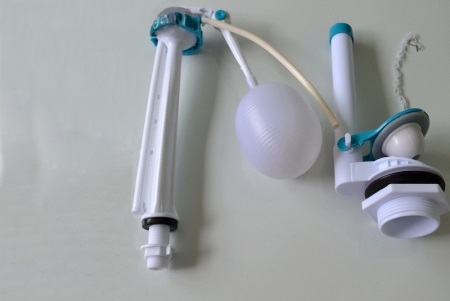
Principle of operation
As we have already noted, the operation of the drain system depends on the functionality of two subsystems - dial and drain.
To understand the intricacies of the work of the entire node is possible only by a separate consideration of each unit.
Water set
Fittings to regulate the water supply come in different types:
- With a side supply. In such cases, the valve is mounted at the top. As a rule, such systems are found among domestic manufacturers of toilets. It is explained by the cheapness of the mechanism. But at the same time it is characterized by increased noise during operation. The models of medium and expensive price category provides for the installation of a tube. Through it, the water is fed to the bottom, thereby reducing the noise level.
- With the bottom feed. It is found in domestic and foreign-made toilet bowls. The noise is minimal, which explains the popularity and demand for the system.
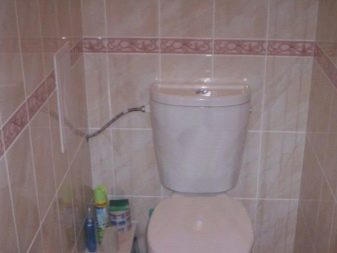
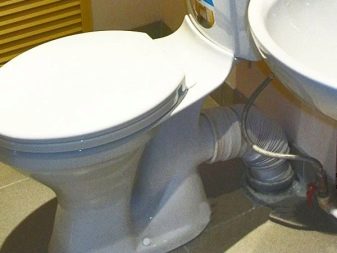
Drain
To activate the drain, it is necessary to pull the rod or press the button. The most popular and modern version is equipped with a button and a lever. If the cistern is hidden, that is, mounted in the wall, the button is placed on the wall. Because of this, hanging toilets have both advantages and disadvantages. A characteristic negative feature - it is difficult to repair, because the fixture can be reached only through a small hole.
The push-button system has 1 or 2 modes, as we have already noted. For large families, it is advisable to buy a version with two modes, allowing you to flush a smaller or larger amount of liquid, depending on the button you pressed.
Some models with two modes of operation are made with one button. Here, flushing less or more depends on how much the button was pressed.
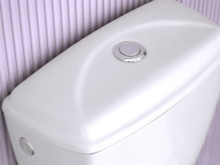
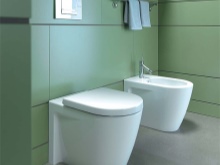
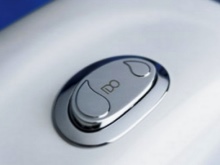
Installation methods
Today there are several ways to install the drain tank. Each of them has its own nuances, advantages and disadvantages.
- Fixation above the bowl of the toilet bowl. In terms of aesthetics, not the best option. Reminds me of the solutions of Soviet times. But it is easy to repair, no special skills are required. The plus is the fact that the water moves downward under the force of gravity, from this bowl is washed more effectively.
- Mounting on the toilet bowl or a special stand. There is a similar option more often than others. For reliable mounting and avoiding leaks between the bowl and the tank install rubber gaskets - cuffs. Aesthetically pleasing, compact, rational.
- Mounting into the wall. The method is relevant only if you are planning a major renovation for your sanitary unit. For this method, you need to install a container in the wall, and the drain button outward. It is interesting because only the bowl is visible. This saves space, provides a more attractive appearance of the room. But the repair is difficult, because you can get to the fittings only through the hole under the drain button on the wall.

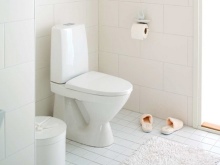
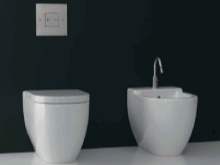
Parts
The purchase of spare parts to repair the toilet bowl - it is quite natural. Many malfunctions are solved by replacing components, fittings or entire units.
To the spare parts of the drain system can include valves, overflow system, pear, buttons, all kinds of fittings, feeding flexible hoses and even a full-fledged tank. After all, this is a ceramic product, which means that it is not difficult to damage it through mechanical action.
Of course, some components can be repaired by using epoxy glue, sealants and so on. But experts do not recommend doing this, since most of these mini repairs give only a temporary effect. You will have to replace the part anyway. So why not buy a new part right away? This will save you time, effort, and also ensure that you can continue to operate the toilet quietly, without fear that at the most inopportune moment, temporary measures will turn into a whole problem.
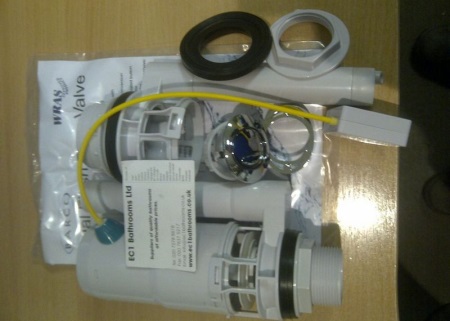
Particulars of choice
Buying spare parts is not at all as simple a process as it may seem. Our tips can help simplify the task.
- If you have an overhead drain, then the assemblies can be made of different materials. It is best to take bronze or brass ones. They are reliable, durable metals that are not afraid of corrosion and exposure to chemicals.
- In standard tanks, mechanisms are mostly separate. That is, the drain and fill valves are made separately. This greatly facilitates repair, does not require additional costs for the purchase of the node, which remained intact.
- Be sure to check the quality of products. Particular attention to the valves. Under their own weight, their actuation should be clear, the nodes should move smoothly, without obstacles. If you notice that there is jamming, then such an element is not worth buying.
- Buying new gaskets, pay attention to the products made of silicone. They are characterized by durability, reliability, in this component are significantly superior to their rubber counterparts. Bend them, unbend them, squeeze them. Good parts do not start to crack, they do not show signs of deformation.
- Stick to the "more expensive means better" rule. Good parts cannot be cheap, despite the high competition among manufacturers, which forces them to reduce prices.
- If an element is reinforced by rubber, that is excellent. This indicates a high degree of responsibility of the manufacturer for their product.
- If you choose bad parts for the drain, the consequences will not be the most pleasant. As a rule, they manifest themselves in the form of leaks.
- Study the quality of metal products. They can have chips, cracks, scratches, broken geometry, blatant traces of welding. All of these are signs of bad parts.
- If it is difficult to determine your own choice, act as simply and competently as possible. Remove the damaged element from your toilet and bring it to the store. A specialist will help you find a decent analogue of high quality. But in this case, you need to be sure that the store where you go.

Possible problems
Even the best quality and most reliable drain systems can fail over time. As practice shows, the most popular problems are the constant inflow of liquid inside the tank, or leakage from the tank.
There can be several reasons for this:
- Skewed float. This problem is the easiest to solve because repair is not required in such a case. Open the lid, manipulate the float so that it falls into its rightful place. Sometimes, though, the shutoff valve itself will not seat properly. This can be corrected manually by driving the valve into the hole.
- The float mechanism does not work properly. Fill to the theoretical limits, however, after which the refill does not stop. Check if the system is working properly by raising the float as high as possible. If the water does not stop flowing, the news is not good - the float will have to be replaced.
- The shutoff valve is not seated tightly in the seat or the seal has aged. The problem is that the seal has worn out over time. It has aged and there is nothing you can do about it. If you press on the valve with your hand and the water stops, then the gasket is definitely the culprit. It is not difficult to replace it. But there are other reasons related to the small weight of the locking mechanism. You don't have to change anything. Just add some weights inside, which will allow you to weight the element.
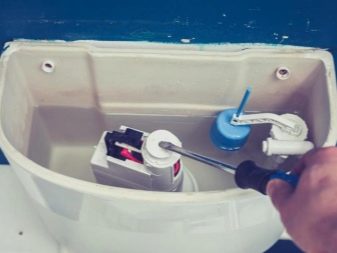
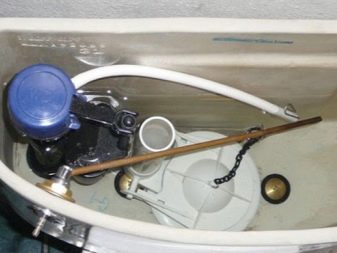
As you can see, the drainage system works differently because of the peculiarities of design, but the essence of its principle of action in this case does not change.
The best solution to avoid breakages and unpleasant leaks - is to buy high-quality plumbing, as well as periodically carry out preventive measures. But most importantly - learn how to handle plumbing with care. No sudden pulling with excessive force by the ropes, no strong pressure on the button, avoid hitting the tank. We recommend placing a filter on the spigot through which the water flows from the water supply line to the tank. It will allow you to detain large particles, thereby avoiding clogs, excessive wear and tear of the elements.




